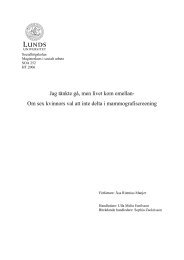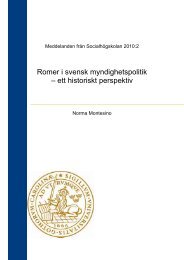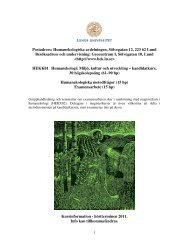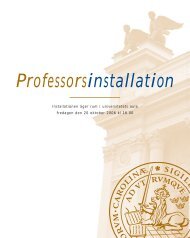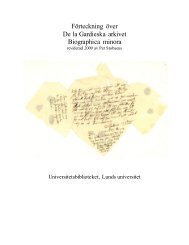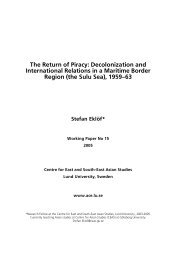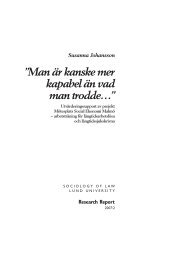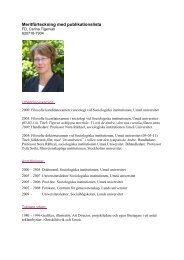Universitetsplatsen in Lund - Lunds universitet
Universitetsplatsen in Lund - Lunds universitet
Universitetsplatsen in Lund - Lunds universitet
Create successful ePaper yourself
Turn your PDF publications into a flip-book with our unique Google optimized e-Paper software.
<strong>Lund</strong> University today<br />
<strong>Lund</strong> University is one of Europe’s<br />
lead<strong>in</strong>g universities. Here, history and<br />
tradition lay the ground for the study<br />
and research environments of tomorrow.<br />
The university offers education and research<br />
with<strong>in</strong> eng<strong>in</strong>eer<strong>in</strong>g, science, law,<br />
social sciences, economics and management,<br />
medic<strong>in</strong>e, humanities, theology,<br />
f<strong>in</strong>e art, music and theatre. Inter action<br />
with bus<strong>in</strong>ess and the community<br />
ensure that knowledge and <strong>in</strong>novations<br />
benefit society.<br />
The university has 47,000 students<br />
and 6,300 staff from all over the world,<br />
based ma<strong>in</strong>ly <strong>in</strong> <strong>Lund</strong>, Malmö and<br />
Hels<strong>in</strong>gborg. The university works with<br />
680 partner universities <strong>in</strong> more than 50<br />
countries.<br />
A short history<br />
With the Treaty of Roskilde <strong>in</strong> 1658,<br />
Denmark lost the counties of Skåne,<br />
Blek<strong>in</strong>ge and Halland to Sweden.<br />
<strong>Lund</strong> University was founded <strong>in</strong><br />
1666 as a step <strong>in</strong> the process of mak<strong>in</strong>g<br />
Skåne Swedish. There had previously<br />
been a studium generale <strong>in</strong> <strong>Lund</strong> for the<br />
tra<strong>in</strong><strong>in</strong>g of priests, founded <strong>in</strong> 1438 and<br />
operational <strong>in</strong>to the 16th century.<br />
The new university was given the<br />
name Regia Academia Carol<strong>in</strong>a. Initially<br />
there were the four classic faculties –<br />
theology, law, medic<strong>in</strong>e and philosophy.<br />
The university did not have any<br />
premises of its own for teach<strong>in</strong>g. At the<br />
end of the 17th century Karl XI donated<br />
<strong>Lund</strong>agårdshuset to the university,<br />
which thus acquired its first ma<strong>in</strong> build<strong>in</strong>g.<br />
The real rise of the university came<br />
dur<strong>in</strong>g the 18th century. Chairs were established<br />
<strong>in</strong> new subjects and the number<br />
of students <strong>in</strong>creased. In 1852 the univer-<br />
Academic ceremonies<br />
The pr<strong>in</strong>cipal ceremonies <strong>in</strong> the <strong>Lund</strong><br />
academic year are the doctoral degree<br />
ceremony and the <strong>in</strong>auguration of<br />
new professors. At the doctoral degree<br />
ceremony, the faculties of the university<br />
present the outward and visible signs<br />
of doctoral dignity (laurel wreath, hat<br />
and r<strong>in</strong>g) to those who have completed<br />
a doctoral degree and to jubilee and<br />
honorary recipients. The ceremony takes<br />
place each year <strong>in</strong> late May.<br />
The <strong>in</strong>auguration of newly appo<strong>in</strong>ted<br />
professors takes place twice a year, <strong>in</strong><br />
autumn and <strong>in</strong> spr<strong>in</strong>g. The ceremony<br />
is held <strong>in</strong> the assembly hall <strong>in</strong> Universitetshuset.<br />
<strong>Lund</strong> University is the only Swedish<br />
member of two <strong>in</strong>ternational networks,<br />
the League of European Research<br />
Universities (LERU) and Universitas 21,<br />
<strong>in</strong> which lead<strong>in</strong>g universities cooperate.<br />
<strong>Lund</strong> University is <strong>in</strong> the middle of an<br />
<strong>in</strong>tensive development phase. The university<br />
has been <strong>in</strong>creas<strong>in</strong>gly successful<br />
<strong>in</strong> obta<strong>in</strong><strong>in</strong>g research fund<strong>in</strong>g <strong>in</strong> competition<br />
and its operations are expand<strong>in</strong>g.<br />
Two of the world’s lead<strong>in</strong>g materials research<br />
facilities are be<strong>in</strong>g built <strong>in</strong> <strong>Lund</strong><br />
– MAX IV and ESS. Ideon Medicon<br />
Village is also be<strong>in</strong>g established and<br />
will offer a unique environment for life<br />
sciences; by <strong>in</strong>tegrat<strong>in</strong>g research, <strong>in</strong>novation<br />
and enterprise, the conditions are created<br />
for improved health and wellbe<strong>in</strong>g.<br />
sity was given new statutes that replaced<br />
the outdated regulations <strong>in</strong> force, and the<br />
state took over responsibility for f<strong>in</strong>ances.<br />
In the 1880s the first few female students<br />
began study<strong>in</strong>g <strong>in</strong> <strong>Lund</strong>.<br />
In the late 19th century, the Faculty<br />
of Philosophy was divided <strong>in</strong>to a Faculty<br />
of Humanities and a Faculty of Science.<br />
In 1964 the social sciences were broken<br />
off from the humanities and <strong>in</strong> 1969 the<br />
<strong>Lund</strong> Institute of Technology (LTH)<br />
became the Faculty of Eng<strong>in</strong>eer<strong>in</strong>g.<br />
Later additions have <strong>in</strong>cluded the School<br />
of Social Work and the Faculty of F<strong>in</strong>e<br />
and Perform<strong>in</strong>g Arts.<br />
In 1900 there were only 1,000<br />
students <strong>in</strong> <strong>Lund</strong>, a small elite who<br />
were educated for higher public office<br />
as priests, teachers, doctors and lawyers.<br />
<strong>Lund</strong> University grew strongly throughout<br />
the 20th century and is today one<br />
of Scand<strong>in</strong>avia’s largest <strong>in</strong>stitutions of<br />
higher education and research.<br />
Newly graduated doctors.<br />
Photographs on page 1. Top: The university founta<strong>in</strong> with the four spout<strong>in</strong>g “faculty frogs”.<br />
Centre left: One of the four sph<strong>in</strong>xes on the roof of Universitetshuset. Centre right: Kilian<br />
Stobaeus the elder (1690–1742). The bust is by Walter Runeberg and was erected <strong>in</strong> 1906.<br />
Bottom left: Palaestra et Odeum. Bottom right: The steps up the assembly hall <strong>in</strong> the atrium<br />
of Universitetshuset.<br />
2<br />
8<br />
3<br />
1. Universitetshuset 2. <strong>Lund</strong>agård 3. <strong>Lund</strong>agårdshuset 4. The university founta<strong>in</strong><br />
5. Palaestra et Odeum 6. Archaeologicum 7. The rune stones 8. The Academic Society (AF)<br />
<strong>Universitetsplatsen</strong><br />
On the site of the present <strong>Universitetsplatsen</strong><br />
lay the university’s first botanical<br />
gardens, founded <strong>in</strong> the middle of the<br />
18th century. In the 1860s, the presentday<br />
botanical gardens were laid out on<br />
Östra Vallgatan and for a few years the<br />
old gardens, Gamla Botanicum, served<br />
as a general meet<strong>in</strong>g place for the people<br />
of <strong>Lund</strong>, with a restaurant, dr<strong>in</strong>k<strong>in</strong>g<br />
of spa waters, concerts and many other<br />
activities.<br />
When the new university build<strong>in</strong>g<br />
was to be erected, most of the old trees<br />
and bushes had to be sacrificed and only<br />
a few have been preserved for us today.<br />
The oldest of the magnificent magnolias,<br />
which have become a symbol of <strong>Lund</strong><br />
University, were planted just before the<br />
First World War.<br />
<strong>Universitetsplatsen</strong> was conceived<br />
by Helgo Zettervall as a harmonious<br />
Helgo Zettervall<br />
In 1874 Helgo Zettervall (1831–1907) was<br />
commissioned to design the new university<br />
build<strong>in</strong>g. He had come to <strong>Lund</strong><br />
<strong>in</strong> 1860 to succeed Carl Georg Brunius<br />
<strong>in</strong> the work to renovate the Cathedral, a<br />
task which took almost 20 years. Dur<strong>in</strong>g<br />
this time, Zettervall acquired a varied<br />
private practice, and the greater part of<br />
his production is to be found <strong>in</strong> <strong>Lund</strong>.<br />
His works <strong>in</strong>clude the façade of the obser-<br />
4<br />
7<br />
whole, with Universitetshuset and<br />
the Academic Society (AF) opposite<br />
one another. As a counterbalance to<br />
<strong>Lund</strong>agårdshuset on the south side of<br />
the square, Zettervall erected Palaestra<br />
et Odeum on the north side.<br />
In the centre stands a two-storey<br />
founta<strong>in</strong> with bas<strong>in</strong>s <strong>in</strong> porphyry, ris<strong>in</strong>g<br />
from a sunken pool surrounded by<br />
flowerbeds. The four iron frogs spout<strong>in</strong>g<br />
water around the base of the founta<strong>in</strong><br />
are popularly known as the “faculty<br />
frogs”.<br />
The whole of <strong>Lund</strong>agård, from<br />
the renovated Cathedral <strong>in</strong> the south<br />
to <strong>Universitetsplatsen</strong> <strong>in</strong> the north,<br />
bears the mark of Zettervall’s creative<br />
imag<strong>in</strong>ation. The founta<strong>in</strong> is entirely<br />
Zettervall’s work; he was assisted by the<br />
Danish landscape gardener H. Fl<strong>in</strong>dt <strong>in</strong><br />
lay<strong>in</strong>g out the gardens.<br />
vatory <strong>in</strong> Stadsparken,<br />
Parkskolan, Katedralskolan’s<br />
entry<br />
towers and w<strong>in</strong>g<br />
along Svanegatan, Helgo Zettervall.<br />
Universitetshuset, Palais<br />
d’Ask, the old surgery (Gamla kirurgen),<br />
the hospital chapel (Lasarettskapellet),<br />
his own house at Sandgatan 14,<br />
Allhelgonakyrkan and the Monument.<br />
1<br />
6<br />
5<br />
Universitetshuset<br />
Universitetshuset (University House),<br />
the ma<strong>in</strong> university build<strong>in</strong>g, was<br />
erected <strong>in</strong> 1878–1882 and designed<br />
by Helgo Zettervall. The build<strong>in</strong>g is<br />
an example of the classically <strong>in</strong>spired<br />
architecture of the 19th century. The<br />
elaborate decoration required a lot of<br />
work. A special workshop was established<br />
expressly for the task of mould<strong>in</strong>g<br />
and cast<strong>in</strong>g the ornamental details.<br />
Today the build<strong>in</strong>g houses the offices of<br />
the university management and parts of<br />
the central adm<strong>in</strong>istration, and provides<br />
facilities for official enterta<strong>in</strong>ment<br />
and ceremonies.<br />
The Atrium<br />
The gallery surround<strong>in</strong>g the atrium<br />
rests on polished granite columns <strong>in</strong><br />
Tuscan-Doric style. The Doric frieze is<br />
decorated with symbols of the faculties<br />
of Theology (star and palm leaf) and<br />
Philosophy (torch and laurel). Dentils,<br />
ovoli, palmettes and other ornaments<br />
drawn from classical antiquity adorn<br />
the Ionian frieze on the first floor. The<br />
glass cupola was renovated <strong>in</strong> 1974. The<br />
old glass panes were replaced with over<br />
700 new, beautifully hand-pa<strong>in</strong>ted ones.<br />
The Assembly Hall<br />
Up a flight of stairs from the atrium<br />
is the assembly hall (aulan). Over the<br />
door is the Greek <strong>in</strong>scription “mhden<br />
amouson”, mean<strong>in</strong>g “without the<br />
muses, noth<strong>in</strong>g (achieved)”, referr<strong>in</strong>g to<br />
the n<strong>in</strong>e classical goddesses believed to<br />
protect science and art.<br />
Our attention <strong>in</strong> the assembly hall is<br />
drawn to the beautiful pa<strong>in</strong>ted ceil<strong>in</strong>g<br />
and the magnificent gilded chandeliers.<br />
A recurr<strong>in</strong>g ornament – seen both<br />
<strong>in</strong> the assembly hall and around the<br />
outside of the build<strong>in</strong>g – is the frieze<br />
of classical rosettes, a decoration which<br />
was also used by Zettervall <strong>in</strong> other<br />
contexts.<br />
High up <strong>in</strong> the w<strong>in</strong>dow recesses are<br />
symbols represent<strong>in</strong>g the university and<br />
the four orig<strong>in</strong>al faculties.<br />
Nowadays the assembly hall is used<br />
for the formal <strong>in</strong>auguration of professors,<br />
concerts, degree ceremonies and<br />
conferences.<br />
Pelarsalen<br />
Down two flights of stairs from the<br />
Atrium is Pelarsalen (the pillared<br />
hall), used by the university for official<br />
enterta<strong>in</strong>ment. The present colour<strong>in</strong>g<br />
is the work of architect Klas Anshelm.<br />
Pelarsalen was orig<strong>in</strong>ally designed as<br />
a museum, but has long been used for<br />
receptions and university functions<br />
of various k<strong>in</strong>ds. On the walls hang<br />
portraits of former monarchs.<br />
Above:<br />
Universitetshuset<br />
with the<br />
magnolias <strong>in</strong><br />
bloom.<br />
Left:<br />
The atrium.<br />
Below: A<br />
ceremony <strong>in</strong><br />
the university<br />
assembly hall<br />
and a close-up<br />
of the elaborate<br />
decoration<br />
on the ceil<strong>in</strong>g of<br />
the hall.<br />
Bottom:<br />
Pelarsalen.



